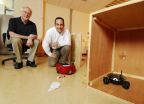(Press-News.org) Liquid water has interacted with the Martian surface throughout Mars' history, measurements by NASA's Phoenix Mars Lander suggest.
The findings, published in the Sept. 10 issue of the journal Science, also suggest that liquid water has primarily existed at temperatures near freezing, implying hydrothermal systems similar to Yellowstone's hot springs on Earth have been rare on Mars throughout its history.
These surprising results come from measurements Phoenix made in 2008 of stable isotopes of carbon and oxygen in the carbon dioxide of the Martian atmosphere. Isotopes are variants of the same element with a different number of neutrons, such as carbon-12, with six neutrons, and the rarer carbon-13, with seven.
Unprecedented precision in determining the ratios of isotopes in Martian carbon dioxide sheds new light on the history of water and volcanic activity on the surface of Mars.
The measurements were performed by the Evolved Gas Analyzer on Phoenix, part of the lander's Thermal and Evolved Gas Analyzer, or TEGA, an instrument designed and built at the University of Arizona. TEGA's mass spectrometer was capable of a more accurate analysis of carbon dioxide than the ones on NASA's Viking landers in the 1970s, the only other such instruments that have returned results on isotopic composition from Mars.
"We use the TEGA instrument as a crime scene investigator," said William V. Boynton, a professor at the Lunar and Planetary Lab in the UA's department of planetary sciences. "Like a chemical fingerprint, isotopes tell us what process is responsible for making the material we are studying." Boynton, who heads the group that built the TEGA instrument, co-authored the Science paper.
Carbon dioxide makes up about 95 percent of the Martian atmosphere. NASA's Mars Exploration Program has put a high priority on learning more about the isotope ratios in Martian carbon dioxide to supplement the information from Viking and from analysis of meteorites that have reached Earth from Mars.
For the measurement, the TEGA instrument on the lander opened a pin-point-sized hole while a vacuum sucked a puff of Martian atmosphere into its chamber for isotope analysis.
The analysis revealed that carbon dioxide on Mars has proportions of carbon and oxygen isotopes similar to carbon dioxide in Earth's atmosphere. This unexpected result reveals that Mars is a much more geologically active planet than previously thought. In fact, the new results suggest that Mars has replenished its atmospheric carbon dioxide relatively recently, and that the carbon dioxide has reacted with liquid water present on the surface.
"Atmospheric carbon dioxide is like a chemical spy," said Paul Niles, a space scientist at NASA's Johnson Space Center in Houston and lead author of the paper. "It infiltrates every part of the surface of Mars and can indicate the presence of water and its history."
The low gravity and lack of a magnetic field on Mars mean that as carbon dioxide resides in the atmosphere it will be lost to space, a process that favors loss of the lighter carbon-12 isotope compared to carbon-13. Although an older atmosphere on Mars should contain much more carbon-13, it doesn't. This suggests that the Martian atmosphere has been recently replenished with carbon dioxide emitted from volcanoes, and volcanism has been an active process in Mars' geologically recent past.
Another clue comes from the second element that makes up carbon dioxide: oxygen. Oxygen, like carbon, comes in different isotopes: oxygen-16 and the heavier oxygen-18.
The team compared the results from Phoenix to measurements obtained from Martian meteorites that were hurled into space from the Red Planet's surface during impact events and eventually fell onto Earth where they were later collected. The meteorites contain carbonate minerals that form only in the presence of liquid water and carbon dioxide.
"Carbon dioxide spewed into the atmosphere by volcanoes is very similar in its oxygen isotope ratio to that found in rocks," said Boynton. "But we see a big difference between the oxygen ratios of the volcanic rocks and the atmosphere."
This suggests that the carbon dioxide in the volcanic rock of Martian meteorites has reacted with liquid water, enriching the oxygen in carbon dioxide with heavier oxygen-18.
The comparisons of isotopes in Mars' atmosphere with those in the meteorites provide confirmation of key findings. For example, one meteorite that crystallized during recent geological time on Mars -- about 170 million years ago rather than billions of years ago -- has carbonates with isotopic proportions that match the atmospheric measurements by Phoenix.
According to Niles, the isotopic signature indicates that liquid water has been present on the Martian surface recently and abundantly enough to affect the composition of the current atmosphere. It also reveals the water has primarily existed at temperatures near its freezing point.
The results provide supporting evidence that the watery conditions associated with carbonate formation have continued even under Mars' current cold and dry conditions.
"This shows that the carbonates formed under the influence of water and the atmosphere in the recent geologic past," Boynton said.
Niles added: "The findings do not reveal specific locations or dates of liquid water and volcanic vents, but geologically recent occurrences of those conditions provide the best explanations for the isotope proportions we found."
INFORMATION:
The University of Arizona conceived of and ran the Phoenix mission, which landed near the north pole of Mars in May of 2008; it is the first Mars mission ever led by a university. The Principal Investigator is Peter H. Smith, a professor at the UA's Lunar and Planetary Lab. NASA's Jet Propulsion Laboratory in Pasadena, Calif., provided the management of the project. For his leadership on the TEGA project, Boynton was recently honored with NASA's Exceptional Public Service Medal.
Phoenix Mars Lander finds surprises about red planet's watery past
An instrument designed and built at the University of Arizona measured the isotopic composition of the Mars atmosphere, providing information about water on the planet
2010-09-09
ELSE PRESS RELEASES FROM THIS DATE:
The pros and cons of Miscanthus -- uses more water, leaches less nitrogen
2010-09-09
URBANA – In the search for the perfect crop for biofuel production, Miscanthus has become the darling to many. But in an effort to not be charmed by its enormous potential for biomass production, researchers at the University of Illinois are taking a careful look at the pros and cons of its behavior in the field.
A recent study analyzed water quantity and quality in plots of Miscanthus, switchgrass, corn, and soybeans and found that Miscanthus used substantially more water, but reduced the potential for nitrogen pollution to water bodies.
"We found that Miscanthus ...
Researchers give robots the capability for deceptive behavior
2010-09-09
A robot deceives an enemy soldier by creating a false trail and hiding so that it will not be caught. While this sounds like a scene from one of the Terminator movies, it's actually the scenario of an experiment conducted by researchers at the Georgia Institute of Technology as part of what is believed to be the first detailed examination of robot deception.
"We have developed algorithms that allow a robot to determine whether it should deceive a human or other intelligent machine and we have designed techniques that help the robot select the best deceptive strategy to ...
Overweight and obese make up majority in Ontario
2010-09-09
OTTAWA – September 9, 2010 --- New analysis of a landmark health survey by the University of Ottawa Heart Institute (UOHI) shows that 70% of Ontario adults are either overweight or obese, and have a strong prevalence of high blood pressure that could lead to heart attack or stroke.
The research, led by Dr. Frans Leenen of the Heart Institute's Hypertension Unit, adds new information to a limited amount of Canadian data on obesity and high blood pressure. The analysis further strengthens the link between high blood pressure and above normal Body Mass Index (BMI), a formula ...
People learn new information more effectively when brain activity is consistent, research shows
2010-09-09
AUSTIN, Texas—People are more likely to remember specific information such as faces or words if the pattern of activity in their brain is similar each time they study that information, according to new research from a University of Texas at Austin psychologist and his colleagues.
The findings by Russell Poldrack, published online today in the journal Science, challenge psychologists' long-held belief that people retain information more effectively when they study it several times under different contexts and, thus, give their brains multiple cues to remember it.
"This ...
Study says shortage of FSC wood statewide could lead to price premium for green construction
2010-09-09
It's no secret: the United States is in the thick of a "green trend." Increased awareness of and commitment to sustainability and improving the environment through reduced carbon emissions and energy use have led to more consumer demand for "green" products, including green construction. Even with the downturn in the housing market, a 2008 poll showed that 91 percent of registered voters nationwide would still pay more for a house if that meant a reduced impact on the environment.
The same is true for the commercial building industry, as construction companies prioritize ...
Keeping stem cells from changing fates
2010-09-09
Johns Hopkins researchers have determined why certain stem cells are able to stay stem cells.
The report in the June 4 issue of Cell Stem Cell reveals that an enzyme that changes the way DNA is packaged in cells allows specific genes to be turned on and off, thereby preventing a stem cell from becoming another cell type.
Each cell has to fit in 6 feet of highly organized and carefully packaged DNA. Some regions of the DNA are more tightly compacted than others and this structure is dynamic. There are specific enzymes that change how condensed the DNA is to help turn ...
Child's 'mental number line' affects memory for numbers
2010-09-09
As children in Western cultures grow, they learn to place numbers on a mental number line, with smaller numbers to the left and spaced further apart than the larger numbers on the right. Then the number line changes to become more linear, with small and large numbers the same distance apart. Children whose number line has made this change are better at remembering numbers, according to a new study published in Psychological Science, a journal of the Association for Psychological Science.
Remembering numbers is an important skill—in life, which is full of social security ...
Research and insights on severe asthma in children
2010-09-09
New Rochelle, NY, September 9, 2010—A subset of children with asthma suffers from severe, treatment-resistant disease associated with more illness and greater allergic hypersensitivity, according to the results of the National Heart, Blood, and Lung Institute's Severe Asthma Research Program (SARP), presented in a recently published article in Pediatric Allergy, Immunology, and Pulmonology, a peer-reviewed journal published by Mary Ann Liebert, Inc. (www.liebertpub.com). The article is available free online at www.liebertpub.com/pai
Asthma is the most common chronic lung ...
Opioid use to relieve pain and suffering at end of life is safe in hospital-at-home setting
2010-09-09
New Rochelle, NY, September 9, 2010—Patients who choose to spend their last days at home with specialized care and monitoring can safely be given opioids to control pain and other symptoms without reducing survival time, according to a study published in Journal of Palliative Medicine (JPM), a peer-reviewed journal from Mary Ann Liebert, Inc.(www.liebertpub.com). The article is available free online at www.liebertpub.com/jpm
The use of high-dose opioids to relieve symptoms such as pain and shortness of breath in hospital- or hospice-based end-of-life care is proven to ...
23rd ECNP Congress: Europe's largest scientific meeting on mental health
2010-09-09
Amsterdam, The Netherlands, September 2010
More than 7,000 psychiatrists, neurologists, psychologists and neuroscience researchers from all over the world met at the 23rd Congress of the European College of Neuropsychopharmacology (ECNP) from 28 August to 1 September 2010 in Amsterdam.
The ECNP Congress is the largest scientific meeting on mental health in Europe, and this year included 46 sessions presented by more than 150 distinguished speakers from 20 countries. In addition, three poster sessions with in total more than 750 poster presentations from scientists ...
LAST 30 PRESS RELEASES:
Numbers in our sights affect how we perceive space
SIMJ announces global collaborative book project in commemoration of its 75th anniversary
Air pollution exposure and birth weight
Obstructive sleep apnea risk and mental health conditions among older adults
How talking slows eye movements behind the wheel
The Ceramic Society of Japan’s Oxoate Ceramics Research Association launches new international book project
Heart-brain connection: international study reveals the role of the vagus nerve in keeping the heart young
Researchers identify Rb1 as a predictive biomarker for a new therapeutic strategy in some breast cancers
Survey reveals ethical gaps slowing AI adoption in pediatric surgery
Stimulant ADHD medications work differently than thought
AI overestimates how smart people are, according to HSE economists
HSE researchers create genome-wide map of quadruplexes
Scientists boost cell "powerhouses" to burn more calories
Automatic label checking: The missing step in making reliable medical AI
Low daily alcohol intake linked to 50% heightened mouth cancer risk in India
American Meteorological Society announces Rick Spinrad as 2026 President-Elect
Biomass-based carbon capture spotlighted in newly released global climate webinar recording
Illuminating invisible nano pollutants: advanced bioimaging tracks the full journey of emerging nanoscale contaminants in living systems
How does age affect recovery from spinal cord injury?
Novel AI tool offers prognosis for patients with head and neck cancer
Fathers’ microplastic exposure tied to their children’s metabolic problems
Research validates laboratory model for studying high-grade serous ovarian cancer
SIR 2026 delivers transformative breakthroughs in minimally invasive medicine to improve patient care
Stem Cell Reports most downloaded papers of 2025 highlight the breadth and impact of stem cell research
Oxford-led study estimates NHS spends around 3% of its primary and secondary care budget on the health impacts of heat and cold in England
A researcher’s long quest leads to a smart composite breakthrough
Urban wild bees act as “microbial sensors” of city health.
New study finds where you live affects recovery after a hip fracture
Forecasting the impact of fully automated vehicle adoption on US road traffic injuries
Alcohol-related hospitalizations from 2016 to 2022
[Press-News.org] Phoenix Mars Lander finds surprises about red planet's watery pastAn instrument designed and built at the University of Arizona measured the isotopic composition of the Mars atmosphere, providing information about water on the planet


